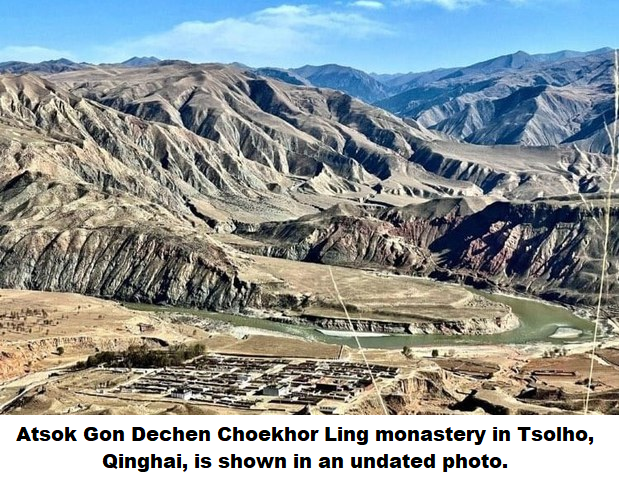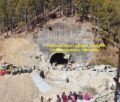China’s attitude toward climate crisis threatens Tibet with water scarcity

China’s illegal takeover of Tibet has gotten worse over time and has become a constant issue that raises great concern.
Tibet was once a land where people’s livelihoods were mostly dependent on farming, and rearing animals and adopting the nomadic lifestyle were also common. But Since China’s occupation, severe climate changes have made the Tibet an region vulnerable and the ice glaciers are melting at a concerning rate.
The climate crisis of Tibet must be on China’s top list of concern and care since they claim to own the land, but China, since their occupation of the land has used Tibet , its people and its land for their own growth, be it socially or economically.
Tibet is known as the “roof of the world” and is also called at times the “water tower of Asia”. It is home to the world’s third largest ice water source and provides water through its river sources to almost 2 billion of the Asian population, reported Tibet Press.
But the alarming rate of increasing climate crisis in the nation is creating a worry for its future.
The matter that causes the most worry is the fact that the drastic changes in the ecosystem would affect other aspects including agriculture and water that will eventually affect the livelihoods of the people who rely on Tibet for their water resources. The Tibet an plateau will apparently go through a great water loss due to global warming in this century itself.
There have been warnings also released regarding how the severity of climate change will result in a change in the hotspots also. The reservoirs of the Tibet an Plateau that cover major parts of southern China and northern India rely fully on the monsoon for its water source and currently supply and fulfil the water demand of two billion people.
Scientists however are finding it difficult to predict the ways in which the warming temperatures and the frequent changes in the weather patterns related to climate change will stir up the region’s water storage.
This is mainly because of the complicated terrain of the Tibet an plateau. Over the two decades, satellite -based measurements have been used by researchers in China and the United States to know the net change in water and ice mass.
The Tibet an Plateau had reportedly lost over 10 billion tonnes of water a year since 2002 because of the escalating changes in the warm and wet climate, reported Tibet Press.
A study by researchers in China and the United States shows that the changes in the water storage all over the plateau seemed to have happened under a middle-of-the-road emissions scenario where the levels of carbon pollution stayed roughly at the current levels before falling gradually after 2050.
Out of all the water sources, two river basins have been specifically pointed out to be the most vulnerable ones. Central Asia’s largest river, the Amu Darya shows a water loss that could be equal to 119 per cent of the current demand.
The communities who rely on the Indus basement for water supply could also see a great loss that equals 79 per cent of the current demand.
The anticipated shortfall will happen gradually but the researchers and authors have urged the governments to also look for alternative water supply options which can include more groundwater extraction.
The director of the Penn Centre for Science, Sustainability and the Media, Michael Mann has stated that “substantial reductions in carbon emissions over the next decade” would help in the limitation and reduction of the global warming that is increasing at a rapid rate. He has also stated how this would particularly also limit the “predicted collapse of the Tibet an Plateau water towers”.
The rivers have been covered with dams and numerous hydro projects that have affected the flow of the rivers and become an area of concern for the other Asian countries that depend on these for water, reported Tibet Press.
However, China, which is the biggest emitter of carbon dioxide is making no efforts to reduce the emission of greenhouse gases or take charge of its irresponsible actions towards creating a climate crisis in Tibet as well as the world.
According to a CNN report, China overtook the US in annual emissions in 2006 and has remained the world’s biggest emitter ever since. Carbon emissions by China tripled between 2000 and 2019. Meanwhile, carbon emissions by the US have dropped slightly over the past decade, according to published figures.
The country releases nearly 30 per cent of the carbon dioxide produced in the world by human activities, according to figures that surfaced during the climate summit in Glasgow in 2021; COP26.
In 2019, China emitted 9. 9 billion tonnes of carbon dioxide, according to an estimate by the International Energy Agency. The emission by the US that year was 4. 7 billion tonnes. According to the Global Carbon Atlas, for 2019, the respective figures for China and the US were 10. 5 billion tonnes and 5. 2 billion tonnes.
The occurrence of such climate crisis is due to human activities or mining of fossil fuels and oils, deforestation and emissions from power plants and cars. Tibet ‘s land in a nutshell has been stripped bare of its richness and purity.
The climate crisis is an issue that must receive the utmost attention at this stage since the impacts are already being seen and the ones that will happen in the future will also be unavoidable###
-
Book Shelf
-
 Book Review
DESTINY OF A DYSFUNCTIONAL NUCLEAR STATE
Book Review
DESTINY OF A DYSFUNCTIONAL NUCLEAR STATE
- Book ReviewChina FO Presser Where is the fountainhead of jihad?
- Book ReviewNews Pak Syndrome bedevils Indo-Bangla ties
- Book Review Understanding Vedic Equality….: Book Review
- Book Review Buddhism Made Easy: Book Review
- Book ReviewNews Elegant Summary Of Krishnamurti’s teachings
- Book Review Review: Perspectives: The Timeless Way of Wisdom
- Book ReviewNews Rituals too a world of Rhythm
- Book Review Marx After Marxism
- Book Review John Updike’s Terrorist – a review
-
-
Recent Top Post
-
 Commentaries
Impasse over BRI Projects in Nepal
Commentaries
Impasse over BRI Projects in Nepal
-
 CommentariesNews
Yet another Musical Chairs in Kathmandu
CommentariesNews
Yet another Musical Chairs in Kathmandu
-
 CommentariesTop Story
Spurt in Anti-India Activities in Canada
CommentariesTop Story
Spurt in Anti-India Activities in Canada
-
 NewsTop Story
Nepal: Political Stability Under Threat Again
NewsTop Story
Nepal: Political Stability Under Threat Again
-
 NewsTop Story
Accountability Tryst With 2024 Ballot….
NewsTop Story
Accountability Tryst With 2024 Ballot….
-
 NewsTop Story
What Would “Total Victory” Mean in Gaza?
NewsTop Story
What Would “Total Victory” Mean in Gaza?
-
 CommentariesTop Story
The Occupation of Territory in War
CommentariesTop Story
The Occupation of Territory in War
-
 CommentariesTop Story
Pakistan: Infighting in ruling elite intensifies following shock election result
CommentariesTop Story
Pakistan: Infighting in ruling elite intensifies following shock election result
-
 CommentariesTop Story
Proforma Polls in Pakistan Today
CommentariesTop Story
Proforma Polls in Pakistan Today
-
 CommentariesTop Story
Global South Dithering Away from BRI
CommentariesTop Story
Global South Dithering Away from BRI
-
AdSense code



















